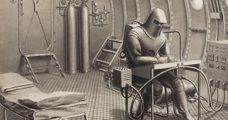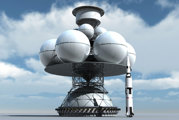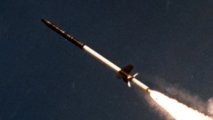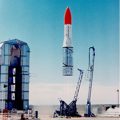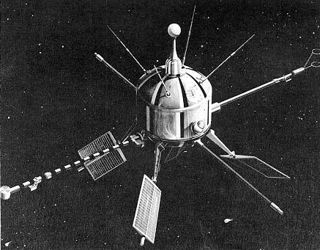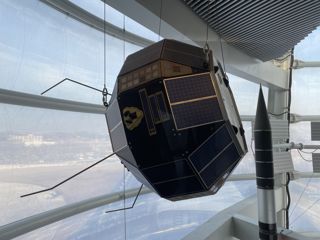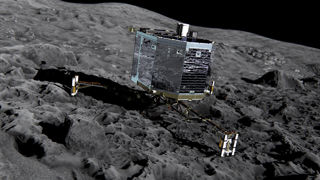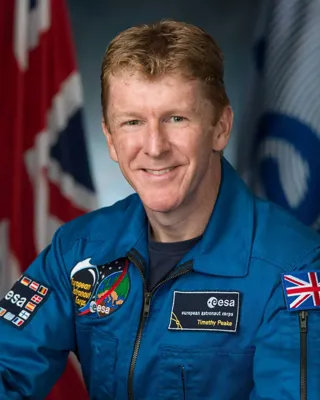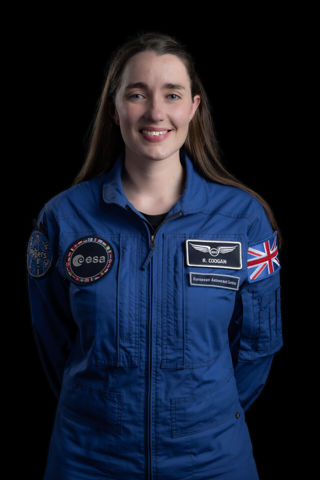
British Space Shenanigans
- 12th Sep 2025
- Author: Ed Kellond-Turner
When you think about space, you probably conjure images of men on the Moon, the Space Shuttle roaring off the launch pad, and spacecraft landing on Mars. But these achievements all come from across the pond by the folks at NASA. What about the UK? What space-related shenanigans have we been up to since the dawn of the space age?
The British Interplanetary Society
Long before NASA was preparing to send humans to the lunar surface, a small group in Britain was preparing their own set of complex missions. This was the British Interplanetary Society. Formed in 1933, the aims of this group of likeminded individuals can best be explained with a quote from its creator, Philip Cleator:
"the ultimate aim of the society, of course, is the conquest of space and thence interplanetary travel"
In 1946, the BIS submitted a proposal to the UK government to develop a human rated rocket they called Megaroc. Sadly, this project was rejected, especially disappointing as some have suggested this would have resulted in the first person in space being British rather than from the Soviet Union.
Even before this the BIS had lofty plans. They designed a lunar lander, space-based telescopes, and interplanetary probes long before they became a reality. They even designed a lunar-rated spacesuit for living and working on the Moon, although this does admittedly look a little bit more like a suit of armour than a spacesuit.
One of the more ambitious projects the society conceived was Project Daedalus, which proposed a rocket engine that could accelerate a craft to 12% of the speed of light. A big ask even with today's technology, let alone in 1978 when the project was created.
While some of their creations today remind us of science fiction, the BIS remains a key aspect of British space science, and has inspired generations of space enthusiasts, including American president John F. Kennedy who first set down the goal of landing humans on the Moon, and Stanley Kubrick, who wrote 2001: A Space Odyssey with long time BIS member Arthur C. Clark.
British Rockets
The first British rocket was Skylark, which could hoist scientific equipment up to space, though it didn't have the capability to launch satellites into orbit. Beginning in 1957, the Skylark rocket would go on to launch 441 times, allowing scientists to investigate the upper atmosphere, the Sun, and the Moon, including the very first good-quality x-ray images of the solar corona. In 2005, the final Skylark rocket took off from Sweden, ending what was at the time the longest rocket programme in the world.
Originally designed as a missile, Blue Streak became the first stage of a joint European launch vehicle called Europa, with France and Germany providing the second and third stages respectively. Europa was launched eight times, with Blue Streak performing flawlessly each time. Unfortunately, the same cannot be said for the rest of the launch vehicle, which failed every time for various reasons, leading the British government to withdraw from the project. Undeterred, the French pushed on, eventually developing the incredibly successful Ariane series of launch vehicles. Read more about the Blue Streak rocket on display in our Rocket Tower here.
The Black Arrow is where the UK officially took off as a major player in space. Dubbed 'the flying lipstick' by space enthusiasts, it gave the UK the ability to launch satellites into orbit from the Woomera launch site in Australia. Unfortunately, with costs mounting, the British government decided to move funding away from rockets towards satellite technology, leaving the UK still as the only country to have abandoned the ability to launch satellites into orbit. In 1971, the Black Arrow flew for the fourth and last time, placing the appropriately named Prospero satellite into orbit. In Shakespeare's The Tempest, Prospero gives up his powers, perhaps a subtle dig from engineers at the British government?
British Missions to Space
The United Kingdom has been involved in developing and building equipment and instruments for spacecraft since 1962. Take a look at some of the most interesting missions British scientists and engineers have been involved in.
-
![Artist's impression of Ariel 1]()
NASA Ariel 1
The launch of Ariel 1 in 1962 saw the United Kingdom become only the third country to operate a satellite in space after the US and Soviet Union. Constructed in the UK with aid from the Americans and named after a character from Shakespeare's The Tempest, Ariel 1 was built to study the Sun's influence on the Earth's ionosphere. Britain turned to the United States to help carry Ariel 1 to space, utilising a Thor-Delta rocket to push the satellite into an elliptical orbit. Only a few months after its launch, Ariel 1 was severely damaged by Starfish Prime, and the satellite's orbit decayed in 1976.
-
![A model of Prospero at the National Space Centre]()
National Space Centre Prospero
Launched in 1971 on the Black Arrow rocket, Prospero became the first British satellite launched on a British rocket. The aim of this mission was to test technology to be used on future communications satellites, including lightweight solar cells and cell coating, as well as telemetry and power systems. The satellite remained operational for two years until its tape recorders stopped working, though ground teams still contacted the satellite annually until 1996 when it was officially deactivated. Prospero remains in orbit to this day, and is not expected to re-enter Earth's atmosphere until around 2070.
-
![Artist's Impression Of The Beagle 2 Lander]()
ESA Beagle 2
Beagle 2 was a British Martian lander that hitched a ride on ESA's Mars Express. Designed to be incredibly cheap and lightweight, Beagle 2 entered into Mars' atmosphere on Christmas Day 2023, though no signal was ever returned to Earth, leading scientists to assume the craft had crashed into the planet's surface. Eleven years later, NASA's MRO spacecraft spotted what is believed to be Beagle 2, meaning it had survived the landing, making the UK the third country to land a spacecraft on another planet.
If you want to learn more about Beagle 2 and its rediscovery, take a look at our blog here.
-
![An artist’s impression of the Philae lander on the surface of comet 67P/Churyumov-Gerasimenko.]()
ESA Rosetta and the Philae Lander
The UK played an important role in the creation of the Philae lander, which became the first spacecraft to soft land on a comet in 2014. Firstly, it was Colin Pillinger, the man whose vision also brought about Beagle 2, who pushed for a comet lander on the Rosetta mission. Secondly, it was the Open University and RAL Space who designed and built the Ptolemy laboratory on the Philae lander that discovered complex molecules that could be key building blocks for life. UK scientists were also involved in 10 of the 21 experiments carried on this mission.
-
![BepiColombo Approaching Mercury]()
ESA BepiColombo
Set to arrive in a Mercurian orbit in November 2026, BepiColombo is a joint mission between ESA and JAXA that aims to study Mercury's magnetosphere and internal structure amongst other things. One instrument aboard the spacecraft is MIXS, which was developed and built by a consortium lead by the University of Leicester. MIXS will help map the elemental structure of the surface of Mercury by collecting fluorescent x-rays, and is the first telescope of its kind sent to another planetary body. BepiColombo has already flown by Mercury several times, capturing some amazing images on its way past.
-
![Artist's impression of the Rosalind Franklin Rover]()
ESA Rosalind Franklin Rover
Named after the British scientist who discovered the structure of DNA, the European funded Rosalind Franklin rover is being built in the UK ready for a launch in 2028 on board a US launch vehicle. What makes this rover so special is its drill, which is two metres in length, compared to NASA's Perseverance rover drill which is around three inches long. In 2024, additional funding was allocated to the project by ESA to ensure a landing date at the end of 2030. Let's hope the failures of Beagle 2 have been left in the past for this mission!
British Astronauts
Since Yuri Gagarin's pioneering spaceflight in 1961, over 600 people have reached orbit around the Earth, with two of those flying with the Union Jack on their arm. Take a look at the United Kingdom's astronaut corps below.
-
![Helen Sharman Astronaut Portrait]()
ESA Helen Sharman
On 18 May 1991, Helen Sharman became the first Britain in space. A food chemist working for Mars Confectionary, she applied to a radio advert calling for British astronauts. Her mission, Project Juno, saw her stay aboard Mir for eight days, becoming the first woman to visit the Russian space station. For 24 years, she was the only person to fly to space under the Union Jack, as future British-born astronauts flew with American citizenship.
If you want to read more about Helen Sharman, you can check out our blog here.
-
![Tim Peake Astronaut Portrait]()
NASA Tim Peake
A former Apache helicopter pilot and test pilot, Tim Peake became the first British astronaut to visit the International Space Station in 2015, spending six months conducting several experiments and even a space walk to repair the station's power supply. Tim is an ambassador for STEM, and he engaged with over two million schoolchildren during his time in space. Tim also completed the London marathon while onboard the ISS, though it took him slightly longer than here on Earth.
-
![Astronaut Portrait Rosemary Coogan]()
ESA Rosemary Coogan
In 2022, Rosemary Coogan was selected as Britain's second ESA astronaut candidate, and has recently completed her basic training programme. Rosemary holds two masters degrees in physics and in astronomy, and has worked everywhere from Paris to Hawaii. As of the date of this blog, Rosemary hasn't received her astronaut assignment, but we have our fingers crossed she finds out soon!
-
![Meganne Christian Astronaut Portrait]()
ESA Meganne Christian
In 2022, Meganne became a member of ESA's astronaut reserve. Prior to her application, she led a very busy life, having twice worked at Concordia Station in Antarctica studying atmospheric physics, studying graphene coatings on satellites during parabolic flights on the Vomit Comet, and becoming a researcher for the National Research Council of Italy. Hopefully we will see Meganne join ESA's astronaut corps at some point in the future.
-
![John McFall Astronaut Portrait]()
ESA John McFall
At 19, John McFall was involved in a motorcycle accident that resulted in an amputation of his right leg. Undeterred, John went on to win the Bronze Medal at the Beijing Paralympic Games in 2008, as well as studying to become a Trauma and Orthopaedic Specialist Registrar. In 2022, John was selected to take part in ESA's study into whether people with physical disabilities can become astronauts. Excitingly, that question was recently answered with a massive YES, and John has now been cleared for a possible mission to the ISS
Today, the United Kingdom is a proud member of the European Space Agency, and funds missions and scientific instruments through the UK Space Agency. The space sector in Britain is worth around £17.5 billion every year, and employs around 50,000 people, with those numbers looking to increase over the next few years. We've recently had new investment into the prospect of launching rockets into a polar orbit from Scotland, and hopefully we will soon see more astronauts flying under the Union Jack to low Earth orbit and beyond. And who knows, maybe you could be one of those people designing the next generation of satellites, or building a vital instrument for a spacecraft heading out to Uranus, or even, like myself, be part of a team inspiring the next generation of space enthusiasts. Whatever happens, it's clear that Britain has carved out a place for itself in the history of space exploration, and will continue to do so for years to come.
Full credits / references
(Banner) The United Kingdom from Space. Credit: Jacques Descloitres, MODIS Land Rapid Response Team, NASA/GSFC
(1a) A mock-up of the BIS lunar space suit. Credit: National Space Centre
(1b) An artist's impression of the BIS lunar space suit in use. Credit: British Interplanetary Society
(1c) Members of the BIS welcome Robert C. Truax in 1938. Credit: British Interplanetary Society
(1d) Project Daedalus next to a Saturn V. Credit: British Interplanetary Society/Adrian Mann
(2a) Skylark launches to space. Credit: Science Museum Group
(2b) A Thor-Able and Blue Streak in the rocket tower of the National Space Centre. Credit: National Space Centre
(2c) The Black Arrow takes off from Woomera, Australia. Credit: Science Museum Group
(3a) Artist's impression of Ariel 1. Credit: NASA
(3b) A model of the Prospero satellite at the National Space Centre. Credit: National Space Centre
(3c) Artist's impression of Beagle 2 on the surface of Mars. Credit: ESA
(3d) Artist's impression of Philae on the comet's surface. Credit: ESA
(3e) Artist's impression of BepiColombo above Mercury. Credit: ESA
(3f) Artist's impression of the Rosalind Franklin rover on Mars. Credit: ESA
(4a) Helen Sharman's astronaut portrait. Credit: ESA
(4b) Tim Peake's astronaut portrait. Credit: NASA
(4c) Rosemary Coogan's astronaut portrait. Credit: ESA
(4d) Meganne Christian's astronaut portrait. Credit: ESA
(4e) John McFall's astronaut portrait. Credit: ESA


